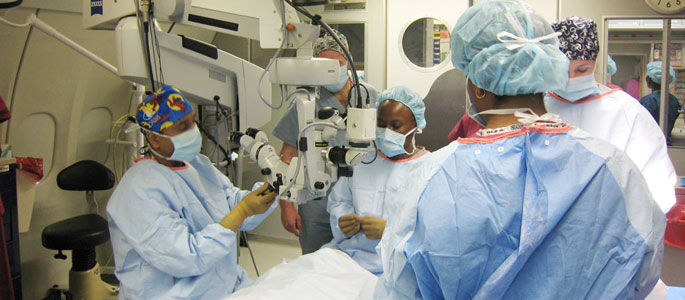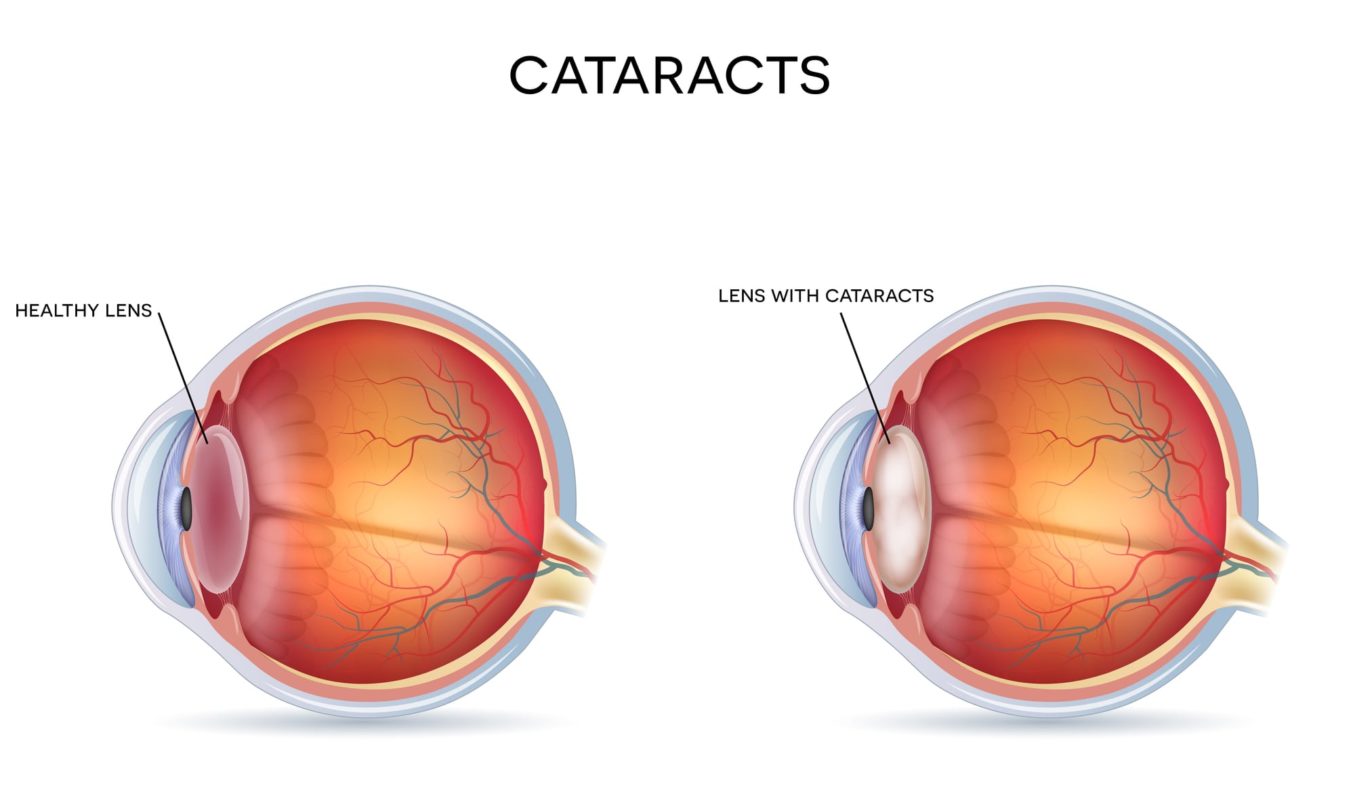What Are Cataracts?
The lens of the eye sits just behind the area of color known as the iris. The lens is like camera film; it takes the light that comes into the front of the eye and focuses it onto the retina to form sharp images of objects. Cataracts form on the eye’s lens as age or other conditions cause proteins within this part of the eye to break down. As proteins clump together, they create a film that clouds vision. Over time, cloudiness worsens and matter accumulates in the tissue of the lens. Usually, cataracts develop in both eyes, though not at the same rate.

What Causes Cataracts?
Cataracts are actually considered an inevitable part of aging and are widespread among people ages 55 years and older. In fact, half of most Ugandans have them—or have had cataract surgery—by age 80. In addition to aging, there are some factors that can increase the risk of developing cataracts.
- Diabetes
- Smoking
- Obesity
- High blood pressure
- Family history of cataracts
- Excessive alcohol use
- Exposure to radiation
Symptoms Of Cataracts
Most people who develop cataracts don’t notice their symptoms at first. Eventually, vision will change as a result of buildup on the lens of one or both eyes. Cataracts may cause symptoms including:
- Cloudy or dim vision
- Blurry vision
- Light sensitivity or sensitivity to glare
- Difficulty seeing clearly at night
- Difficulty reading or performing tasks in lower light
- The appearance of halos around lights
- Colors appear yellow or dull
- Eyeglass or contact lens prescription needs to be changed frequently
- Double vision in one eye
Cataract Treatment
Cataracts can make it difficult to perform normal tasks and engage fully in life. Fortunately, excellent results are typically expected from cataract removal. Cataract surgery is now a relatively brief operation, which can be performed as an outpatient procedure and patients can return home the same day after surgery. Normal activities are usually resumed within a few days.
What Are The Benefits Of Cataract Surgery?
Cataracts can affect how one lives on a daily basis. When clouding and blurriness become severe, a person may no longer engage in activities they once enjoyed. They may avoid driving at night and then avoid driving at all times due to visual challenges. The ways in which poor vision limit activity may lead to struggles with anxiety and depression.
One of the most significant benefits of cataract-removal surgery is that you can get your life back. You can expect to be able to drive and engage in hobbies you may have stopped due to poor quality vision. According to one study, cataract removal surgery can improve quality of life by at least 35 percent.
Studies also suggest that older individuals who undergo cataract surgery decrease the risk of falls and fractures by 16 percent or more. The more severe cataracts are, the greater the percentage of improvement.
Who Are The Ideal Candidates For Cataract Surgery?
Adults who are bothered by an inability to see clearly or perform certain tasks due to blurry or cloudy vision may be excellent candidates for cataract-removal surgery. In some instances, it is necessary to investigate the guidelines set by an insurance company in order to qualify for coverage. If insurance is not a factor, a person may choose to undergo cataract removal at any point they deem it necessary to support their quality of life.
How Is Cataract Surgery Performed?

As part of your cataract surgery , your doctor will typically implant a permanent clear plastic lens to correct your vision. Lens implants are small artificial lenses that are placed in the eye, after the cataract has been removed, to minimize dependence on glasses. Today, your doctor is able to offer you the opportunity to have a lens implant that will correct your distance vision as well as your near vision so that you will be able to minimize your need for glasses in order to see at all distances following your cataract surgery. These lens implants are called near vision-correcting lens implants or presbyopia-correcting lens implants. As part of your cataract evaluation, your doctor and the staff will be sure to discuss the possibility of having near vision presbyopia correcting lens implant as part of your cataract surgery.
In the event that you have a considerable amount of astigmatism, it is also possible to correct that astigmatism using a type of lens implant called a toric lens implant. A toric lens implant, or astigmatism correcting lens implant, can help you see clearly at distance without the need for glasses after cataract surgery but does not correct presbyopia or near vision. For those patients who would like to have the best possible distance vision especially for night vision and low-contrast environments such as at dusk or in rainy conditions, it is possible for your doctor to use a monofocal lens implant which works by eliminating spherical aberration.
Following the removal of cataracts during surgery, the implant is placed in a structure called the capsule. After surgery, this capsule remains clear for some time. This capsule often (20% of patients) becomes cloudy following surgery, which can affect the vision. Should this occur, a YAG laser will be used to do a capsulotomy (make a small opening in the capsule) which will restore the vision.

What Is The Recovery From Cataract Surgery?
Recovery from cataract surgery is generally a simple process. There may be a few post-treatment guidelines to follow but patients tend to find them convenient and helpful. In terms of vision, clarity may be restored within a day, a week, or a month. Every patient is unique in their healing. In general, patients may expect:
- To keep their eye covered in some way for one week after surgery. This may be wearing protective glasses or a shield over the treated eye. The purpose of this is to prevent debris from getting into the eye or inadvertent touching of the eye, which could disrupt the healing incision.
- To avoid certain activities for one week. The pressure within the eye, called intraocular pressure, can place undue stress on the healing incision. To maintain lower eye pressure, we advise patients to avoid straining, lifting objects that weigh more than 10 pounds, and bending with the head below the midsection of the body.
- To insert eye drops for a few weeks after surgery. Antibiotics may also be prescribed to reduce the risk of infection.
- A follow-up visit a few weeks after cataract removal. This eye exam observes vision and evaluates the potential need for prescription eyeglasses.
How Will My Vision Be After Cataract Surgery?
Advancements in intraocular lens options have improved patient outcomes and provide solutions for common vision problems. After cataract surgery, patients can expect to have a crisp, clear vision and minimal need for prescription lenses, if any.
Schedule A Consultation
If you suffer from cataracts and are seeking treatment, contact Georgina Eye Clinic. Call us at 0755 347258 or fill out our online form to schedule a consultation with one of our specialists.
At Georgina Eye Clinic we specialize in treating and managing cataracts and we have an excellent record in helping our patients regain sight from cataract surgery.
